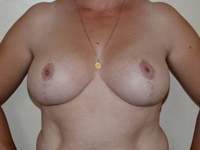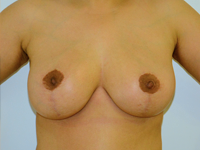BREAST REDUCTION
OBJECTIVES
Breast reduction is a surgical procedure to reduce the size of large pendulous breast that are disproportionate to a woman’s body and can cause physical pain. Technically called reduction mammoplasty, breast reduction improves breast size, shape and the associated conditions of large breasts that include:
» Back, neck and shoulder pain causes by the weight of excess breast tissue
» Shoulder discomfort and indentation from bra straps that support heavy, pendulous breasts
» Restricted physical activity due to breast size and the associated discomfort
» Skin irritation beneath the breast crease
» Sagging, stretched skin and a low breast profile where, when unsupported, the nipple rests below the breast crease
» An enlarged areola caused by stretched skin
Breast reduction surgery removes excess breast fat, glandular tissue and skin to achieve a breast size in proportion with a woman’s body and to alleviate the discomfort associated with overly large breasts. In general, breast reduction surgery will not only correct the functional symptoms associated with large breasts, but will also result in better proportioned breasts, enhancing a woman’s body image and self-confidence.
PREOPERATIVE CONSULTATION
Breast reduction surgery can be performed at any age; however it is best performed when the breasts are fully developed.
In general, good candidates for breast reduction are women of relatively normal, stable weight whose breast development is complete. Breast reduction is best performed on:
» Healthy individuals who do not have a life-threatening illness or medical conditions that can impair healing
» Non-smokers
» Individuals with a positive outlook and specific goals in mind for improving their physical symptoms, breast size and shape Overall health and personal outlook can greatly impact the outcome of breast surgery. The success of the procedure, safety and overall satisfaction require that:
» Honestly share the patient’s expectations with the plastic surgeon
» Fully disclose health history, current medication, the use of vitamins, herbal supplements, alcohol, tobacco and drugs
» Be candid about any history of breast cancer in your family and personal breast health
» Commit to precisely following all of the plastic surgeon’s instructions
PROCEDURE OVERVIEW
Breast reduction is more commonly performed through incisions with surgical removal of the excess fat, glandular tissue and skin that contribute to large, pendulous breasts. The most common approach is a keyhole incision pattern.
The nipple, which remains tethered to its original blood and nerve supply, is then repositioned. The areola is reduced by excising skin at the perimeter, if necessary. The vertical incisions are brought together to reshape the now smaller breast. Non-removable sutures are layered deep within the breast tissue to create and support the newly shaped breasts; sutures, skin adhesives and/or surgical tape close the skin.
There are alternative incision patterns that may be recommended depending on the amount of tissue and skin to be removed and the quality of skin elasticity. One is a circular pattern around the areola. Another is a racquet-shaped pattern with an incision around the areola and vertically down to the breast crease. In any case, the incision lines that remain are visible and permanent scars, although usually well concealed beneath a swimsuit or bra.
In some cases, excess fat may be removed through liposuction in conjunction with excision techniques. If breast size is large due to fatty tissue and excess skin is not a factor, liposuction alone may be used for breast reduction. In every case, the technique used to reduce the size of the breasts will be determined by individual condition, breast composition, amount of reduction desired and patient and surgeon preference.
RECOVERY
After mammoplasty, dressing or bandages will be applied to the incisions and an elastic bandage or support bra will minimize swelling and support the breasts as they heal. A small, thin tube may be temporarily placed under the skin to drain any excess blood that may collect.
Initial healing will include swelling and discomfort at the incision sites. Discomfort is common and can be controlled with medication. A support bra may be recommended around the clock for the first few weeks. A return to light, normal activity is possible usually within a few days of surgery. Any sutures will be removed within 10 days following surgery. The patient will be ready to return to work and normal activity at this time, if she feels comfortable, so long as she does not engage in any heavy lifting or vigorous exercise.
Healing will continue for several weeks as swelling dissipates and breast shape and position settle.
RISKS
Risks of breast reduction include blood pooling beneath the skin (hematoma), blood clots, infection and poor healing at the incision site. Changes in nipple or breast sensation are usually temporary. Smokers are at increased risk for poor wound healing particularly at the nipple and areola and are advised to stop smoking for several weeks before and after surgery. All surgery carries risk associated with anesthesia.
RESULTS
The final results of breast reduction will appear over the next few months as breast shape and position continue to settle. Incision lines are permanent scars, but they will improve over time and can be hidden under most swimsuits.
Because significant amounts of breast tissue are removed, breast reduction surgery may impair the ability to breast feed. Changes in the breast during pregnancy can alter the outcomes of previous breast reduction surgery.
The new breast size should free the patient from the pain and physical limitations experienced prior to breast reduction. Breast reduction is considered permanent although, over time, the breasts may continue to change due to weight fluctuations, aging and gravity.






